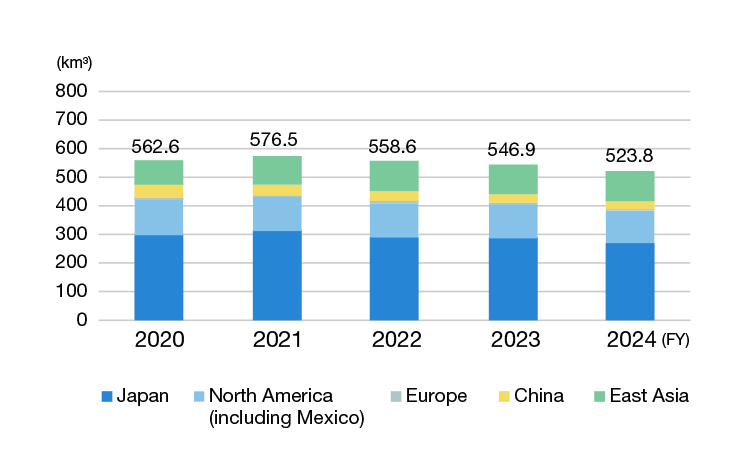Initiatives for a Recycling-Oriented Society and Pollution Prevention
The Tsubaki Group is advancing initiatives designed to help build a circular economy with a low environmental impact by creating higher economic value through the reduced use of resources while promoting the reduce, reuse, recycle (“3R”) approach.
* Three R’s: An abbreviation of Reduce, Reuse, Recycle.
Reducing Total Weight of Waste Discharged
Based on the Four Principles and Eight Items of Sustainability, the Group is working to reduce waste (including both industrial and general waste) and improve recycling rates. In addition to these activities, we have set total weight of waste discharged, which includes recyclables traded for sale, as a unique management indicator that is also one of the items for assessment in the Group’s EcoFactory Certification System.
As a result of efforts to reduce the amount of waste discharged at all business sites in FY 2024, despite a slight rise in the amount of waste due to increased production, because this was exceeded by the reduction in the Sale of Valuable Resources, the total waste discharged decreased compared to the previous fiscal year. Going forward, we will continue with initiatives for realizing a circular economy while effectively utilizing and recycling resources.
List of Total Weights of Waste Discharged, Broken Down by Business Site
Unit: t/year
| FY 2023 | FY 2024 | ||||||
|---|---|---|---|---|---|---|---|
| Waste | Sale of Valuable Resources | Total Waste Discharged | Waste | Sale of Valuable Resources | Total Waste Discharged | ||
| Tsubakimoto Chain | Kyotanabe Plant | 505 | 8,853 | 9,358 | 402 | 7,808 | 8,211 |
| Saitama Plant | 1,485 | 8,619 | 10,104 | 1,490 | 7,756 | 9,247 | |
| Hyogo Plant | 147 | 8 | 154 | 180 | 21 | 201 | |
| Nagaokakyo Plant | 296 | 667 | 963 | 244 | 664 | 908 | |
| Okayama Plant | 248 | 257 | 506 | 344 | 255 | 600 | |
| Affiliated companies | Tsubakimoto Custom Chain Co. | 150 | 585 | 735 | 147 | 614 | 761 |
| Tsubakimoto Sprocket Co. | 98 | 341 | 439 | 120 | 319 | 440 | |
| Tsubakimoto Bulk Systems Corp. | 33 | 228 | 262 | 26 | 169 | 195 | |
| Tsubakimoto Mayfran Inc. | 70 | 646 | 716 | 69 | 584 | 653 | |
| Tsubakimoto Iron Casting Co. | 1,793 | 88 | 1,881 | 1,920 | 104 | 2,024 | |
| Tsubaki Yamakyu Chain Co. | 45 | 54 | 100 | 56 | 56 | 112 | |
| Domestic total | 4,871 | 20,347 | 25,218 | 4,999 | 18,352 | 23,351 | |
Note: Waste = Industrial waste + General waste
List of Emission Intensity
| Total waste discharged/Emission intensity | |||
|---|---|---|---|
| FY 2023 | FY 2024 | ||
| Tsubakimoto Chain | Kyotanabe Plant | 0.419 | 0.370 |
| Saitama Plant | 0.308 | 0.281 | |
| Hyogo Plant | 0.147 | 0.151 | |
| Nagaokakyo Plant | 0.091 | 0.082 | |
| Okayama Plant | 0.095 | 0.095 | |
| Affiliated companies | Tsubakimoto Custom Chain Co. | 0.144 | 0.137 |
| Tsubakimoto Sprocket Co. | 0.131 | 0.133 | |
| Tsubakimoto Bulk Systems Corp. | 0.054 | 0.041 | |
| Tsubakimoto Mayfran Inc. | 0.207 | 0.173 | |
| Tsubakimoto Iron Casting Co. | 1.203 | 1.316 | |
| Tsubaki Yamakyu Chain Co. | 0.028 | 0.032 | |
| Domestic total | 0.269 | 0.243 | |
Note: Total waste ÷ Production
Improvement of Recycling Rate
The Group takes a proactive approach to reducing and recycling waste. In FY 2024, the combined total amount of industrial and general waste was 4,999 tons, representing an increase of 2.6% year-on-year. Although the recycling rate was slightly lower than the previous fiscal year, it remained high at 97.9%.
Going forward, we will strengthen initiatives at all business sites for reducing environmental impact and aim for further improvements.
Waste Emission and Recycling Rate (Fiscal Year Average)
-
Unit: t, %
2020 2021 2022 2023 2024 Industrial waste 4,300 4,708 4,419 4,503 4,635 General waste 345 412 383 367 364 Total 4,645 5,120 4,802 4,871 4,999 Recycling rate
(fiscal year average)96.7 96.8 97.0 98.6 97.9 -

The scope of the report is 11 major business sites in Japan; overseas data is not included, as waste definitions differ from country to country.
Initiatives to Reduce the Use of Hazardous Chemical Substances
The Group is strengthening its initiatives in relation to hazardous chemical substances so that customers can use our products with peace of mind.
Specifically, we are promoting compliance with regulations in Japan and overseas, investigations into products containing chemical substances, and reductions to the chemical substances handled in production processes.
Management of Chemical Substances in Products
The Group investigates the substances contained in raw materials, parts, and other materials. By also working with our customers to gain an understanding of the actual content of such substances and to establish permissible levels, we continue to focus on reducing their use. We also distribute our Green Procurement Guidelines to our main suppliers. These guidelines specify laws and regulations applicable to hazardous chemical substances, the names of those substances, standard values, and so on. We encourage suppliers to understand the importance of controlling chemical substances and to cooperate in reducing their use.
Reducing the Use of Chemical Substances Subject to the PRTR Law
The Group surveys emissions of chemical substances specified by the Chemical Substance Removal Management Promotion Law (PRTR Law) and continuously works to reduce such substances in our production processes and switch to less hazardous substances. In FY 2024, seven business sites at four companies were subject to reporting related to the Law. The Group has adopted PRTR control as a management indicator under the EcoFactory Certification System, and is reducing the use of strictly controlled substances also at plants that are not required to report under this system.
FY 2024 data on chemical substances subject to the PRTR Law
Unit: kg/year
| Business Site | Substance No. | Substance Name | Amount Released | Amount Transferred | Total | |||||
|---|---|---|---|---|---|---|---|---|---|---|
| Atmosphere | Public Water Supply | Soil | On-Site Landfill | Sewer | Transferred to Off-Site Business | |||||
| Tsubakimoto Chain Co. | Kyotanabe Plant | 348 | 1-bromopropane | 8,800.0 | 0 | 0 | 0 | 0 | 0 | 8,800 |
| Saitama Plant | 87 | Chromium and chromium (III) compounds | 69.0 | 0 | 0 | 0 | 0 | 35,000.0 | 35,069 | |
| 300 | Toluene | 16,000.0 | 0 | 0 | 0 | 0 | 6,400.0 | 22,400 | ||
| Hyogo Plant | 438 | Methylnaphthalene | 3.0 | 0 | 0 | 0 | 0 | 0 | 3 | |
| Nagaokakyo Plant | 53 | Ethylbenzene | 1,506.4 | 0 | 0 | 0 | 0 | 119.6 | 1,626 | |
| 80 | Xylene | 2,144.2 | 0 | 0 | 0 | 0 | 169.9 | 2,314 | ||
| 300 | Toluene | 9,936.1 | 0 | 0 | 0 | 0 | 788.8 | 10,725 | ||
| Tsubakimoto Bulk Systems Corp. | 53 | Ethylbenzene | 2,688.0 | 0 | 0 | 0 | 0 | 328.0 | 3,016 | |
| 80 | Xylene | 3,049.0 | 0 | 0 | 0 | 0 | 374.0 | 3,423 | ||
| 300 | Toluene | 1,374.0 | 0 | 0 | 0 | 0 | 187.0 | 1,561 | ||
| 438 | Methylnaphthalene | 1.2 | 0 | 0 | 0 | 0 | 0 | 1 | ||
| Tsubakimoto Mayfran Inc. | 53 | Ethylbenzene | 1,700.0 | 0 | 0 | 0 | 0 | 600.0 | 2,300 | |
| 80 | Xylene | 2,400.0 | 0 | 0 | 0 | 0 | 800.0 | 3,200 | ||
| 300 | Toluene | 10,000.0 | 0 | 0 | 0 | 0 | 3,600.0 | 13,600 | ||
| 737 | Methyl isobutyl ketone | 980.0 | 0 | 0 | 0 | 0 | 360.0 | 1,340 | ||
| 594 | Ethylene glycol monobutyl ether | 800.0 | 0 | 0 | 0 | 0 | 300.0 | 1,100 | ||
| Tsubakimoto Iron Casting Co. | 412 | Manganese and its compounds | 3,488.0 | 0 | 0 | 0 | 0 | 558.8 | 4,047 | |
| Magnesium and its compounds | 2,280.0 | 0 | 0 | 0 | 0 | 91.2 | 2,371 | |||
| Total | 67,219 | 0 | 0 | 0 | 0 | 49,677 | 116,896 | |||
Note 1: Tsubakimoto Custom Chain, Tsubakimoto Sprocket, and Tsubaki Yamakyu Chain are outside the scope of PRTR filing.
Note 2: The values shown in the table above are compliant with laws and regulations.
Conservation of Water Resources
To protect our water resources, the Group is engaged in a global effort to reduce our total water use and water use intensity. At our business sites in Japan, we have adopted voluntary management values for each business site according to the management indicators identified in the EcoFactory Certification System and are taking steps to reduce our water use. In FY 2017, we began measuring water use at our business sites overseas and have adopted measures to reduce it.
-
Water consumption (domestic)

-
Water consumption (global)




